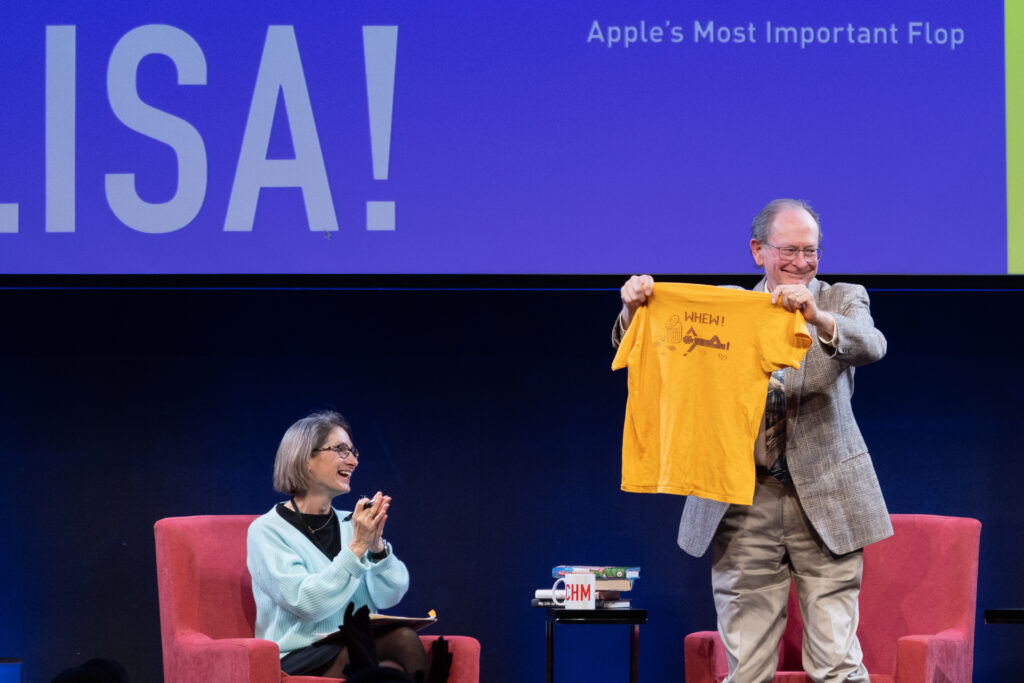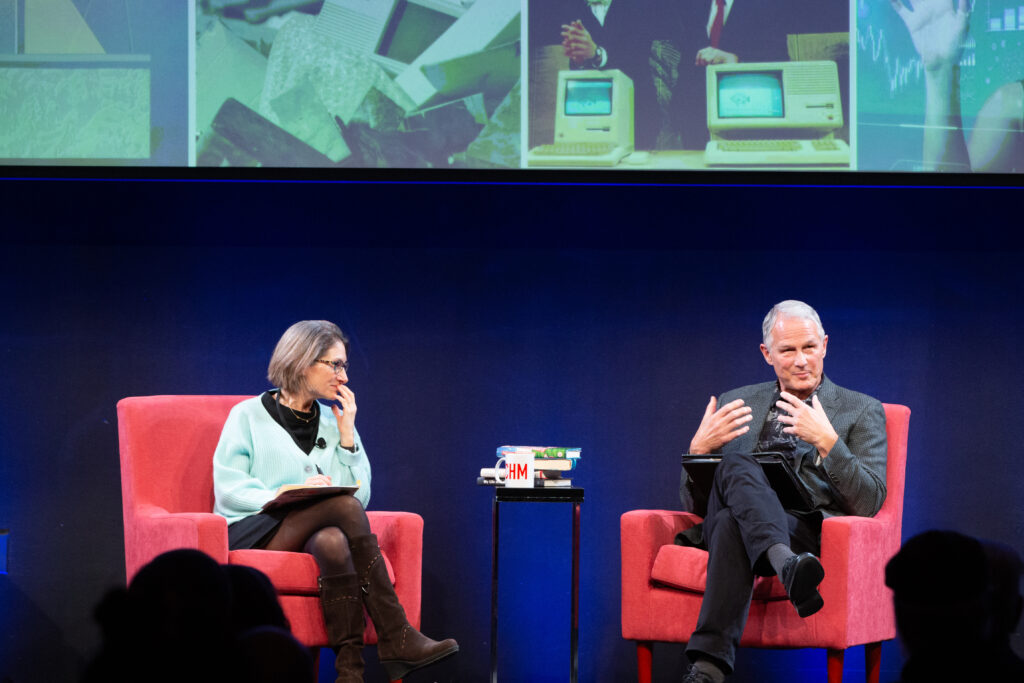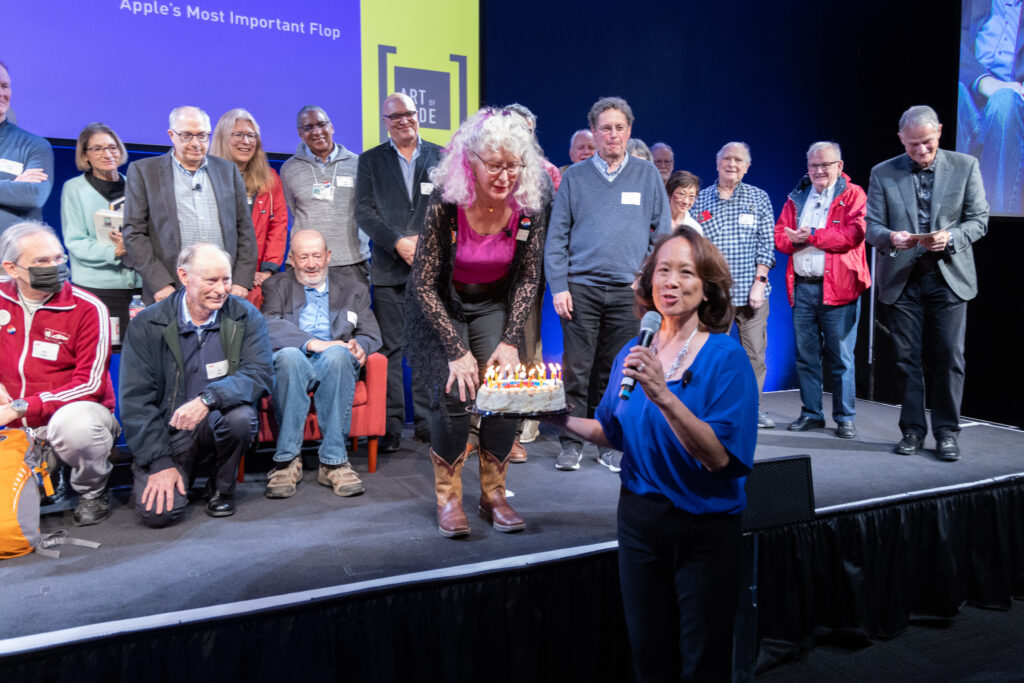
Apple’s Lisa computer debuted in 1983 with an ad starring a young Kevin Costner, but while his career took off, the Lisa did not.
How could a machine that transformed the way people interact with computers also be a commercial flop? CHM gathered key insiders to celebrate the Lisa’s innovations, explore its ongoing impact, and learn lessons from its failure. It was a memorable evening of memories, stories, and swag.

Bruce Daniels shows off his Lisa team T-shirt.
Moderator Katie Hafner, a New York Times contributor and author, kicked off a panel discussion with members of the original Lisa team.
John Couch, general manager of the Lisa division, and Steve Jobs were both in their twenties when, as Couch explained via video, they were trying to figure out how to “help their dads use a computer.” That meant trying to create a new market with a revolutionary new interface that would use icons instead of text-based commands and make computers accessible to anyone. He believes the investment paid off because the Lisa became the foundation of Apple’s future.
Bruce Daniels, Lisa’s software manager, remembered the Apple team’s famous trip to Xerox’s Palo Alto Research Center (PARC). Riding back in Steve Jobs’ car, the two talked about how to turn PARC’s ideas and demos into a product.
Daniels recruited DEC engineer Wayne Rosing, who like everyone (but one) who was interviewed was excited to join the team. Rosing contests that it was the mouse and the graphical interface that changed everything by providing a new, more intuitive alternative to text-based commands. He helped to make the decision to have a one-button, rather than two- or three-button, mouse so that users were spared from making decisions.
Daniels and Rosing agreed that the Lisa’s high price eclipsed the creativity put into it. But they are proud that the machine’s innovations were given life in the Mac.
Bruce Daniels explains how the Mac benefited from the Lisa.
Rosing noted that the graphics system for the Mac, written by Bill Atkinson, was the same one that was in the Lisa. In fact, about thirty percent of the Mac’s code came from the Lisa.
Annette Wagner, who designed the Lisa icons and fonts, was hired by Apple in 1981 as a graphic designer and typographer and “didn’t have a clue” what she was getting into. She and her colleague, Elizabeth Hall, were told they needed to create typefaces that printed out the same as they looked on the screen, introducing them to the term “WYSIWYG.” Then, the designers learned that the screen had rectangular pixels. There was lots of experimentation, Wagner said, and it was “quite an adventure.”
Annette Wagner describes creating icons for the Lisa.
When the laser writer printer appeared, Wagner had to deal with a new world of outline typefaces. Told to contact John Warnock at a new company called Adobe, Wagner’s extensive feedback inspired a major breakthrough—a concept called font hinting. Wagner reminds us that our assumption that what we see on the screen will print out clearly and faithfully is a debt we owe the Lisa.
Developer Bill Atkinson, who worked on the Lisa user interface and created the QuickDraw graphics library, said via video (he missed the event to go on his honeymoon) that it took him only two weeks after he spoke with Steve Jobs to quit his PhD program and join Apple. He was inspired by Jobs’ vision that they would change the world for the better, and he appreciated the care and artistry put into the work. He believes Lisa’s lasting contribution was to make computers available as a tool for anyone to express their creativity—it wasn’t just a machine for nerds.

Katie Hafner speaks with CHM President and CEO Dan'l Lewin.
Dan’l Lewin, CHM president and CEO, was the market development manager for the Lisa. While working for Sony in 1977, he met Steve Jobs, who was in the office next door. Lewin organized a sneak preview program with the product management team to introduce the Lisa to leaders in business and academia. With a full-day agenda, Fortune 500 CEOs had to be present with up to six officers, and they sat in a specially constructed room ($250,000 to build!) with separate bays to view the demo.
The CHM Live audience enjoyed their own demo video as well as a trailer of media partner The Verge’s upcoming documentary. Chris Espinosa, Apple employee #8, provided CHM with the Lisa’s floppies and obtained permission from Apple to share the source code (access the code here). CHM software curator Al Kossow was able to restore the code and run it on a Lisa computer from CHM's collection.
Journalist and Wired Editor-at-Large Steven Levy joined Katie Hafner to discuss the impact of the Lisa and why it was a commercial failure. Price was a huge impediment. At $10,000, the Lisa was competing with the much less expensive IBM PC, which was featured on the cover of Business Week in 1983.
But, says Levy, the Lisa was always considered an experimental machine, the computer of the future, while the workhorse Apple II was supposed to compete with IBM. Experimental technology is always super-expensive the first time around.
Steven Levy talks about transforming lab innovations into a product.
The concept of “going straight into cyberspace with your hand” was an unconventional way of doing computing at the time, notes Levy. The Lisa was always going to be a hard sell in the corporate world, where IT managers, not users, made the buying decisions.
While it’s popular to note that there wouldn’t be a Mac without the Lisa, Levy wondered if the Lisa might have survived without the Mac. What if the Lisa didn’t have to compete for resources at Apple? What if Steve Jobs wasn’t talking up the Mac even before the Lisa was released? Maybe without the Mac, Apple would have figured out how to produce a more affordable version of the Lisa that was open to outside developers.

CHM's VP of Innovation and Programming Marguerite Gong Hancock hands off Lisa's birthday cake to Annette Wagner.
We’ll never know what might have been. But what we do know is that the Lisa computer changed the world of computing. And for that, we can celebrate, which CHM did—with a special birthday wish from Lisa Brennan-Jobs, a birthday cake, and a heartfelt rendition of “Happy birthday to you!”
Happy Birthday Lisa | CHM Live, January 31, 2023
Learn more about the Art of Code at CHM or sign up for regular emails about upcoming source code releases and related events.